
Close your eyes and let all the thoughts of the day fade away. Stare at the blank canvas at the back of your eyelids. Think of colors…yellows, oranges, blues, greens. Imagine these colors vibrantly coming to life in shapes, in movements, in Mexico. Now open your eyes. Welcome to LUZIA.
There is a certain magic that comes with experiencing the circus. Cirque du Soleil is no different, but it is truly in a league of its own. In its fourth decade, the Canadian entertainment company maintains its reputation as a leader in the world of circus arts, continuing to push the limits of creativity and wonder. Each individual involved has a critical role in making this feat a reality and is essential to the functioning of each awe-inspiring production.
Cirque du Soleil publicist Francis Jalbert, started as an intern with the company back in his college days in Montreal, working two days a week over what was supposed to be a 10-week internship. Eight years later, he is still a valuable member of the Cirque family, having worked on the production of both TOTEM and LUZIA.
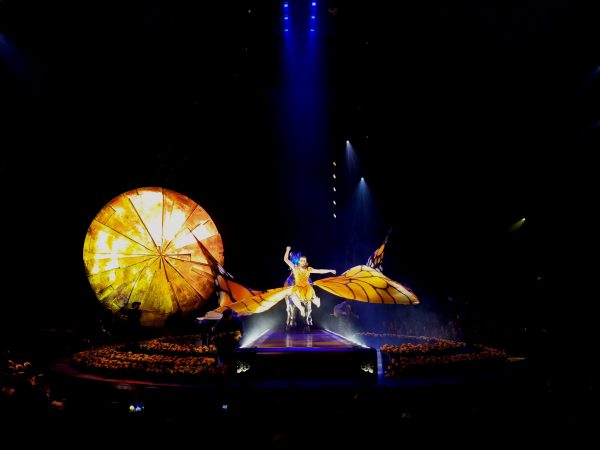
Photo by Camille Bolos | The Signal
What brought you to Cirque du Soleil to begin with?
Jalbert: I studied in PR and communications so I was choosing internships from Montreal where I was studying. [Doing] an internship, you always look for companies that inspire you and I wanted to have the opportunity to work for a company that has global reach, you know, so it’s not just local in terms of media [and] to be able to interact with Cirque du Soleil was amazing. I interned with Cirque du Soleil and then I started working for them, so that was about eight years ago.
How far in advance do you guys start planning the show?
Jalbert: In short, LUZIA will be about two years in the creation process. So, we start with the director who has a vision of what the show will be and then we’ll build around him a team of creators. We’ll have musical composers, set designers, costume designers and so on. For about a year they’ll work on the project trying to bring new ideas to the table and really shape what the show will be on paper while we’re actually casting the show at the same time. I would say the artists would arrive about eight months before opening night and we’ll start training building the acts because some acts are actually built from scratch and new for this show, so [they] start building them and stage the show to be ready for opening night. It’s a long process and I think it’s really unique in the industry the way we create shows, but it starts with an idea that gets bigger and broader.
So how do you find the artists? Do they audition or do you seek them out?
Jalbert: Well we have a casting department in Montreal. We have about 26 casting scouts specialized in different disciplines because the artists come from different backgrounds. People come from a traditional circus, we have people coming from sports, like Kelly, who studied gymnastics her whole life and then did a transition at some point. We have people coming from [the] Canterbury Circus crew who kind of have a degree in circus arts and we have dancers, singers, actors and musicians. We do casting all year round. People can send their videos to our casting department and everybody that sends a video, we actually watch it and decide if there’s a potential there. If there is, we will invite them to a live audition so we can see their talent see what they can bring to one of our productions. At the end of that audition process if we like them we tell them that “Okay great you’re part of the database of Cirque Du Soleil,” but that means that you’ll get a call when there’s a position that fits [who] you are and fits your profile. That can take months years or can be right away as well.
What was the inspiration behind the idea of LUZIA?
Jalbert: With LUZIA we wanted to bring a certain Latin American feel to the show and we worked with director Daniele Finzi Pasca who has lived in Mexico for ten years of his life. He always wanted to find a way to pay tribute artistically to Mexico so it was kind of a match made in heaven for Cirque Du Soleil. We decided to do a show based on the richness of the culture of Mexico but it’s nothing literal. So, through LUZIA you’re traveling around an imaginary world that is inspired by an array of inspirations from Mexico. It can be in the songs of the music, in the locations, landscapes, people, emotions you would feel as you travel around. We created this world so that you can go through different emotions for 2 hours and a half.
Do you guys specialize any part of the show to make it different from other cities? Additional acts that you come up with along the way that you add in?
Jalbert: I wouldn’t say we adapt the show from one city to another because it is a big production. The way we build our shows, we want them to live almost 10 years or even more and then they can travel around the world. [Although], the show keeps growing through time so you could have seen the first performance of LUZIA in Montreal a year and a half ago and now the show that you’ll see here in Atlanta [and] it has grown tremendously. We don’t want the artists to get in a robotic mode because we perform the show about 260 times a year. We want them to stay on their toes and also they want to challenge themselves acrobatically and artistically so the show just gets better and better and keeps growing through time. It’s a well-oiled show that you’re getting here in Atlanta, we’ve done it more than 600 times by now—so we’re pretty ready for you guys!
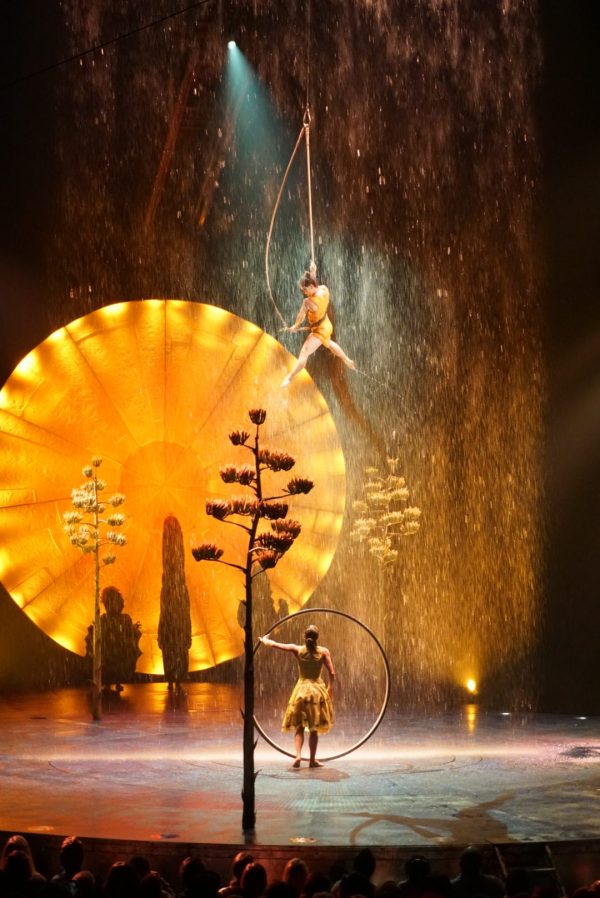
Photo by Sophia Marchese | The Signal
What can audiences expect from the show and the concept?
Jalbert: If you’ve seen Cirque Du Soleil before I think we’re just taking the ideas a step further. Artistically we are able to do things under the big top that have probably most would never have thought possible. So, with LUZIA we integrate a huge element of water so for some of the acts it actually rains on the stage and they perform acrobatics in the rain. We’ll have trapeze artists flying through the rain, [and] we’ll have some artists performing some acrobatics in a pool of water in the center of the stage. So, just that is quite phenomenal to be able to achieve this under the tent and for the audience, it’s magical. As soon as you see the waterfall you get this sort of emotion that’s almost indescribable.
What would you consider to be the fundamental factors that drives the magical fantasy behind it all for an audience?
Jalbert: If you love live entertainment Cirque Du Soleil packages it in the most professional and the most unique way possible. The costumes are amazing, the set design is stunning and the with the technology involved you’ll wonder how we are able to do that. The acrobatics are stunning so even if, let’s say, you don’t like musicals, you’ll be still impressed by the content we are providing. I think to be able to bring people to dream, that’s what we’re doing, like as soon as you step under the tent you forget that you’re in this canvas tent and you just dream with us for two hours and a half. There’s no price to that, that’s amazing. And to see all these people just dream with you is just an experience on its own.
What is the most rewarding part of being a part of Cirque du Soleil?
Jalbert: You know we have 17 countries involved in the cast. When you add all the crew that’s involved, 77 crew members, we come from 24 different nationalities. So, you get the best of the best in different fields working together under this tent and it’s a unique environment. Every day you learn about yourself and about the world and you’re just inspired by the different people that you get to interact with.
What is the hardest part about being on the road?
Jalbert: The hardest part I’d say for many people is that you miss your family and friends. You’re on the road all year long basically. People think that maybe we are on the road for three months and then going back home—no, no no. The show is traveling constantly.
What is the best part about being on the road?
Jalbert: The most interesting part is that month or so [or] every two months we get to pack our suitcases and then you change your routine. You have to find again which grocery store you want to go to, what are the bars or the attractions that you want to see, so it keeps you on your toes.
What’s interesting is that we are this little community that travels around so the people you work with and live with are kind of the only stability you have in your life. So, the bond that you’re building with these people is something unique that probably wouldn’t get in a different type of environment
Are all of you very close-knit?
Jalbert: We are, but also [with] 125 [people] you find your group within the big family. You [also] have this kind of common knowledge and understanding that you would not have maybe with your family back home that is stationary.
Run away with the Cirque
Written by Sophia Marchese
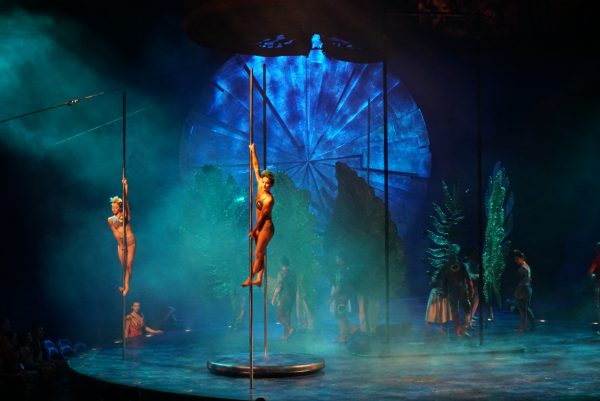
Photo by Sophia Marchese | The Signal
Cirque du Soleil is much more than a mere spectacle. It’s the dreams of both the audience and the performers coming true before your eyes. It’s dedication and hard work and sacrifice. It’s a lifestyle.
Performers from all around the world practice endlessly to achieve their goals and dazzle their audiences. An opportunity to be a part of the largest theatrical production in the world isn’t something that comes along every day, and each circus artist understands this wholeheartedly.
They understand that as a part of this worldwide, world-renowned family, it is their artistic duty to make every crowd feel as if they are slipping into a dream, even if only for a few hours. They translate their passions into live art that induces emotion and awakens the imagination.
Luzia’s artists are no exception. Acrobatic gymnast Kelly McDonald has brought her talent and creativity into the waking dream of Mexico.
In the beginning, what gave you the idea to get professional feedback form Cirque Du Soleil on your existing act?
McDonald: I was invited. In Las Vegas, the acrobatic community and the show community is pretty small. We’re all on the same street, we all have the same hours. It’s not your 9-5—you’re working at night. So I think it’s a really supportive community too. My partner and I had done some nonprofit shows, we did some work at a hospital, we did some charity work with the act that we put together… So then we were invited. Somebody from Cirque had either seen or heard about us as an acrobatic duo and we were invited to a specialty act audition. And we were really excited to get the feedback from that audition. And fortunately, we were actually presented for this role at Luzia and the creation of our act, with the rest of the Adagio team. And it was such a great experience. And the chance to come on tour for the first time for me. So it worked out great for the both of us.
Before being offered a contract with Cirque, was this something that you had thought about as a career move?
McDonald: I thought about it. When you’re in performing, you kind of have a list of things [to check off]. You have resident shows, an arena show, a big top show… But then you also have a creation. And it’s not often that you get that opportunity—to be part of making the show. So even when you’re done and you leave, part of you is still touring the world and part of you is still with that show. It’s something that I wanted to do, but you never know when that opportunity is going to become available. You have to keep your eyes and ears open for when that door opens up for you. I was comfortable living in one place. I had my friends living in one place… So it was a bit of a scary decision to make also because it’s leaving something your comfortable with for the unknown, but it was worth it.
What kind of steps do you take after being offered a contract? Any medical evaluations?
McDonald: Absolutely. So with Cirque du Soleil, they want to make sure that I’m in a condition where I can stay safe and my partner stays safe and that we’re fit enough to do the job that they want us for. So everyone has a physical we have to take and continue to take as a performer—you take it every year. Just to make sure that you’re maintaining. It’s for our own protection as well as to protect the company.
Did you have any fears going into this?
McDonald: Absolutely. Moving… You’re joining a cast of people you don’t know… For me—Adagio is actually a very acrobatic number. And the team consists of five people. So I’m a flyer, there’s another flyer and we alternate, and there’s three porters. So it’s working with people that you must trust. Not only artistic presentation, but I trust them with my health, my wellness, my safety. And they have to trust me, too—that I’m going to know what to do when we’re doing our tricks, and that we can perform high-level things together. And that was built during the creation… We had some days of up to 14 hours together in the studio. We worked seven months before the opening of the show. To get to know each other, trust each other, and to build a huge vocabulary of things that we could do… And then narrow it down to what works—with the music, with the set, with other performers that complement our act.
What does your act represent?
McDonald: In Luzia, our act is called Adagio. And it’s kind of a nostalgic feel—the music is absolutely beautiful. It’s more of a touching number than the really fun ‘get-out-of-your-seat-and-cheer number.’ For me, it represents hardworking people and relationships throughout your life. And it also represents strength—not only because my porters throw and catch me and they are really strong—I think the flyer represents a lot of strength, too, and grace throughout the act.
Do you try to connect with the audience personally in your act? How so?
McDonald: Definitely. Eye contact is really big for me. We can see you! The theater has a lot of seats but it feels very intimate. I like to take moments and scan and really see somebody [in the crowd]. And I can tell when they see me back. And I like to take a look around and mix that with the acrobatics that we’re doing. It’s not like watching a sports event… I come from sports and it’s a transition into performing. We do perform high-level acrobatics, but with more of an emotional feel to it.
What’s your background in sports?
McDonald: I did gymnastics my whole life. I competed in NCAA for four years at the University of Washington. And that’s when I made the transfer into performing and acrobatics.
And was there something that inspired that transition?
McDonald: I still loved being physical and I loved that I had an entire life of experience, building air awareness, building strength and body awareness, and when I learned that there was an opportunity to continue to do all of this… I jumped on it. I didn’t know really how far it could go. And I’ve learned that it can be a career—it really can. And after all of this, you can continue to be involved with shows or with Cirque du Soleil. It’s such a big and inviting company that you have a lot of opportunity for growth.
Walk me through the process of getting ready for the show. Hair, makeup, etc.
McDonald: We all do our own makeup and that takes between 30 and 40 minutes. We do our own hair for the act as well. We had designers that come up with which designs they want for each performer, and then we learned how to do [the designs] ourselves during the creation [process]. The makeup definitely went through an evolution. It changed throughout creation… So when it was finally set, it was about learning the lines and the colors and the blending—and once you have it, your hands kind of know what to do.
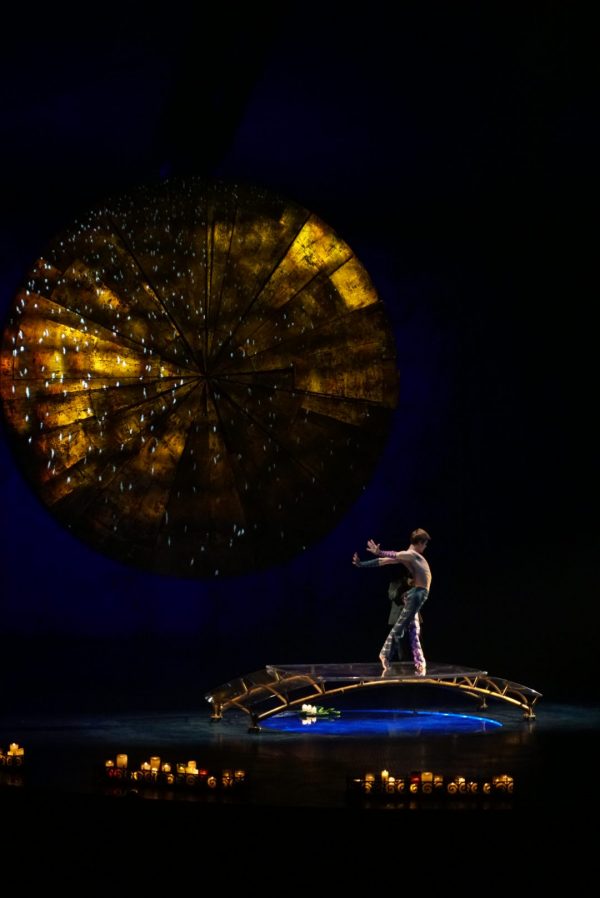
Photos by Sophia Marchese & Camille Bolos | The Signal
What kind of training do you do before each show?
McDonald: We do between eight and 10 shows a week. Either between two and four days a week we’ll have one show and then the rest of the days we’ll do two shows in one day. So it depends… If you have one show you’ll usually spend more time doing trainings because you have more time in the day. Each act has their own requirements—different strength training, different cardio. Me, personally, I like to get outside. So before I come to the Big Top, I’ll go running, go find something active to do that’s outside or go explore different opportunities in each city—which is really exciting about touring. And then when we come in, we have a kitchen so we can get our meals in and then do our trainings as well. So we’ll do an hour of Adagio training on our 1-show days and I back-up some other acts so I’ll do some trapeze training… And I like to train other elements as well.
How do you, as an artist, continue to challenge yourself and develop your skills?
McDonald: We have a chance to learn from a lot of different performers that have different skill sets. So I take the opportunity to learn different apparatus, to learn different languages. You get to communicate, you get to learn different cultures while [we’re] in one tent all together. And then it’s also great to see the dynamic of moving around the country and the world, and how that works logistically. And for me, I like to learn about all of that—about the planning and everything that goes into making this big operation work so smoothly.
What is the most rewarding part of being involved in Cirque Du Soleil?
McDonald: For me, I love to see and feel the audience reactions. When [I’m] on stage during [my] act, when [I’m] helping another performer by accompanying them in their act. I get to be amazed by co-workers every day also. And when you go out there and you bow, and you see that people were touched by your performance. And that it could mean something different for everybody that’s there—hopefully it’s something positive for everyone—that’s a really valuable part of my job.
What excites you about bringing Luzia to Mexico, the country that is at the heart of the production?
McDonald: I’m really excited to see their reaction. Hopefully, they’re proud of what we’ve done. It’s something that has created beauty—from the sets to the music, to the actual performances. Everywhere we’ve gone so far people have been amazed and have great reactions. And it’s because of the inspiration that we have from Mexico. So we’re proud of what we’ve done, but it’s because of that inspiration that it’s something that’s so beautiful.
An art, an experience
Cirque du Soleil in itself is an art, and the beautiful thing about art is that each individual has their own interpretation of it. There is no spoken word so the performers are not telling the audience how to feel or what to think. It is a show for all cultures, and each culture will see it through their own eyes due to their own personal experiences. Expose yourself to the sensation of LUZIA and see how you interpret the marvelous production. Cirque du Soleil is at Atlantic Station until Nov. 19, 2017. Students may find discounted tickets starting at 20 percent off on their website.
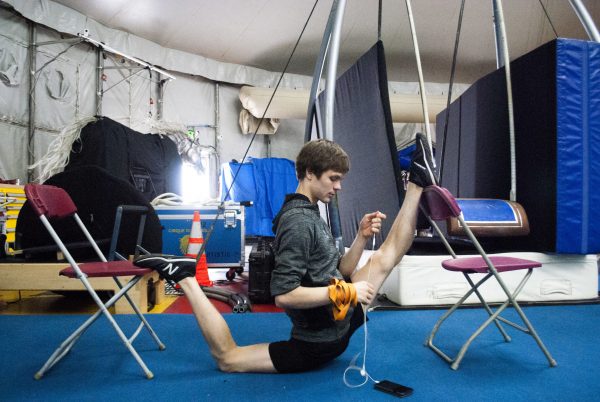
Contortionist: Aleksei Goloborodko
Aleksei Goloborodko, the world’s most flexible human being, graces LUZIA with his unparalleled contortionism. It had been a dream of his from a young age to be a part of Cirque du Soleil. He started training diligently, his flexibility reaching new heights each day. Here he is 16 years later, living the reality of his dream.
